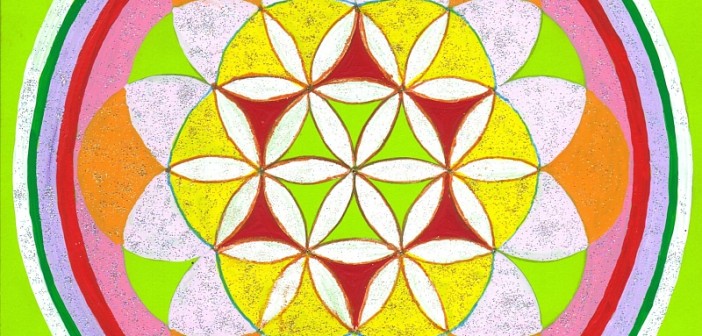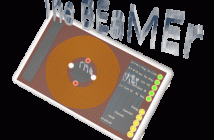This is a short introduction to the miraculous world of mandalas and gives you some ideas how to approach the new CoRe’s Flower of Life mandalas database. The pictures bellow are from this series painted by Irén Vargáné Tóth from Hungary. If you are interested in this new Module for CoRe please contact Pal Nagy at [email protected]
 https://inergetixforum.com/wp-content/uploads/mandala0108.jpg 800w" sizes="(max-width: 297px) 100vw, 297px" />
https://inergetixforum.com/wp-content/uploads/mandala0108.jpg 800w" sizes="(max-width: 297px) 100vw, 297px" />
Mandala derives from the Hindu language meaning ‘concentric energy circle.’ A circle represents protection, good luck, or completion. Mandalas link with the spiraling movement of conscousness sacred geometry, psychology and healing.
Jung’s ‘Mandala Symbolism’
The mandala as psychological phenomena appear spontaneously in dreams, in certain states of conflict, and in cases of schizophrenia. According to the results obtained, when the human brain is generating mandalas, it can be regarded as a complex ‘biochemical reactor’ that creates different images reflecting its internal state (or the distribution of chemicals and their biochemical interactions) and all these processes based on the laws of nature.
Mandalas in Different Cultures
In Hindu cosmology the surface of the Earth is represented as a square, the most fundamental of all Hindu forms. The earth is represented as four cornered with reference to the horizon’s relationship with sunrise and sunset, the north and south direction.
The Earth is thus called ‘Caturbhrsti (four-cornered)’ and is represented in the symbolic form of the Prithvi Mandala. The astrological charts or horoscopes (Rasi, Navamsa, etc) also represent in a square plan the ecliptic – the positions of the sun, moon, planets, and zodiacal constellations with reference to the native’s place and time of birth. The Vaastu Purusha Mandala is the metaphysical plan of a building, temple, or site that incorporates the course of the heavenly bodies and supernatural forces.
The square is the box. We experience ‘inside the box. 4 goes to 4th dimension or time. We experience through the spiraling patterns of sacred geometry in the alchemy of timem moving away from the central source, and then returning.
The basic design of the mandala is found in most cultures.
 https://inergetixforum.com/wp-content/uploads/mandala0007_mod-150x150.jpg 150w, https://inergetixforum.com/wp-content/uploads/mandala0007_mod.jpg 702w" sizes="(max-width: 298px) 100vw, 298px" />
https://inergetixforum.com/wp-content/uploads/mandala0007_mod-150x150.jpg 150w, https://inergetixforum.com/wp-content/uploads/mandala0007_mod.jpg 702w" sizes="(max-width: 298px) 100vw, 298px" />
Western Cultures
In the West, mandala is also used to refer to the “personal world” in which one lives, the various elements of the mandala being the activities and interests in which one engages, the most important being at the centre of the mandala, and the least important at the periphery. Depicting one’s personal mandala in pictorial form can give one a good indication of the state of one’s spiritual life.
Buddhism
Tibetan Sand Mandala
A mandala in tantric Buddhism usually depicts a landscape of the Buddha land or the enlightened vision of a Buddha. Mandalas are commonly used by tantric Buddhists as an aid to meditation. This pattern is painstakingly created on the temple floor by several monks who use small tubes to create a tiny flow of grains. The various aspects of the traditionally fixed design represent symbolically the objects of worship and contemplation of the Tibetan Buddhist cosmology.
To symbolize impermanence (a central teaching of Buddhism), after days or weeks of creating the intricate pattern, the sand is brushed together and is usually placed in a body of running water to spread the blessings of the Mandala.
The visualization and concretization of the mandala concept is one of the most significant contributions of Buddhism to religious psychology. Mandalas are seen as sacred places which, by their very presence in the world, remind a viewer of the immanence of sanctity in the universe and its potential in himself. In the context of the Buddhist path the purpose of a mandala is to put an end to human suffering, to attain enlightenment and to attain a correct view of Reality. It is a means to discover divinity by the realization that it resides within one’s own self.
The mandala is usually a symbolic representation which depicts the qualities of the enlightened mind in harmonious relationship with one another. A mandala may also be used to represent the path of spiritual development. On another level a mandala can be a symbolic representation of the universe, as in one of the four foundation practices of the Vajrayana, in which a mandala representing the universe is offered to the Buddha.
One important type is the mandala of the “Five Buddhas,” archetypal Buddha forms embodying various aspects of enlightenment, the Buddhas depicted depending on the school of Buddhism and even the specific purpose of the mandala. A common mandala of this type is that of the Five Wisdom Buddhas (aka Five Jinas), the Buddhas Vairocana, Aksobhya, Ratnasambhava, Amitabha, and Amoghasiddhi. When paired with another mandala depicting the Five Wisdom Kings, this forms the Mandala of the Two Realms.
Mesoamerica
Mandalas have been designed by Mesoamerican craftsman in the form of calendars.
Celtic Patterns
Knot designs are commonly seen in traditional Celtic art. Like the mandala, Celtic knot designs are by definition rich in symmetries. Knots are commonly shown as a single cord woven in and out of itself to form a symetrical design.
Native American
To the Native American the mandala symbolizes the shield of good luck. With this shield it is believed the gods would protect them. By having one in their home, it would bring them prosperity, good health, and happiness. To some tribes a mandella was considered a shield. It was a prized possession of the plains Indians with each area having a specific meaning.
Mandalas are sometimes a variation of the dance shield used by the Plains Indians, influenced by the herders of the West. It was thought to bring its owner good luck, prosperity, wealth, and happiness. Mandalas were originally made from Buffalo hides, Eagle feathers, and wild animal furs. Currently all natural materials are used, which come solely as by-products from domesticated animals.
source: http://www.crystalinks.com/
 https://inergetixforum.com/wp-content/uploads/mandala0014_mod.jpg 800w" sizes="(max-width: 297px) 100vw, 297px" />
https://inergetixforum.com/wp-content/uploads/mandala0014_mod.jpg 800w" sizes="(max-width: 297px) 100vw, 297px" />















